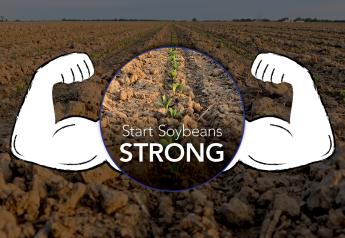Ag Industry: Fine Print To Determine If NAFTA 2.0 Is A Victory

The agriculture industry breathed a collective sigh of relief on Monday when news spread that American, Canadian and Mexican negotiators landed upon a revised North American Free Trade Agreement late Sunday night. At first blush, the new deal called the U.S.-Mexico-Canada Agreement is considered positive for agriculture.
“Today’s announcement regarding the United States-Mexico-Canada Agreement is welcome news. This was a hard-fought win and we commend the administration for all the efforts to solidify the trading relationships we have with our North American neighbors,” Zippy Duval, president of the American Farm Bureau Federation said in a statement on Monday.
According to Pro Farmer policy analyst Jim Wiesemeyer, the deal is a net positive for agriculture. He says it’s also physiologically important because it demonstrates President Trump’s willingness to actually close a major trade deal.
“Farmers across the country have been closely following NAFTA negotiations and reminding the administration of its promise to ‘do no harm’ to agriculture,” Lynn Chrisp president of the National Corn Growers Association said in a statement. “NAFTA has been an unequivocal success story for American agriculture, opening markets that since enactment have become vitally important to U.S. corn farmers, and providing certainty to farmers and the rural economy. We applaud USTR for reaching a new agreement and look forward to thoroughly evaluating it to determine if it continues to benefit American agriculture.”
One of the most significant changes in the deal relates to the contentious dairy chapters of the agreement. USMCA would open up the Canadian dairy market by 3.59%. That’s a bit better than the 3.25% that had been negotiated by the Obama Administration in the Trans Pacific Partnership which was abandoned by President Trump.
As importantly, Canada has agreed to eliminate its Class 6 and Class 7 programs which made U.S. exports of milk protein concentrates uncompetitive. The program was also taking share in other markets, upsetting U.S., European and New Zealand exporting companies.
Jim Mulhern, president and CEO of the National Milk Producers Federation (NMPF), is grateful for the changes.
“This agreement, when implemented, should give us additional marketing opportunities that will allow us to provide high-quality American dairy products to Canada, which means we’ve made incremental progress,” he says. “We appreciate that the Trump Administration continually raised the profile of our issues at the negotiating table.”
Canada dairy farmers are less than positive about the deal.
“This has happened, despite assurances that our government would not sign a bad deal for Canadians,” Pierre Lampron, president of Dairy Farmers Canada, said in a statement. “We fail to see how this deal can be good for the 220,000 Canadian families that depend on dairy for their livelihood.”
(Note: Canadian government is assuring its dairy farmers they will be offered compensation if they are harmed by the new agreement.)
The U.S. dairy groups say that the ultimate benefit of the new USMCA will depend on how it is implemented. The agreement must still be voted on by all three countries, and some of the key provisions of the agreement might not go into effect until 2020.
“Maintaining dairy market access in Mexico and improving market access into Canada were IDFA’s top priorities during the talks to modernize NAFTA,” adds Michael Dykes, president and CEO of the International Dairy Foods Association (IDFA). “This new agreement will preserve our vital partnership with both countries and allow the U.S. dairy industry to seek more export opportunities.”
Similarly, Tom Vilsack, president and CEO of the U.S. Dairy Export Council, says the deal will help U.S. agriculture develop new international markets for many farmers.
“We also need to pursue new free trade agreements with other nations and resolve our trade conflicts with China,” he said in a statement. “It is imperative that the United States remains an integral player in driving the global trade agenda.”
Dairy wasn’t the only U.S. ag sector to receive a win in the Canadian negotiations. Wheat producers should be pleased as well. The USMCA revises the way wheat imports into Canada are graded, a long-held point of contention between the U.S. and Canadian wheat industries.
“The current North American Free Trade Agreement (NAFTA) is critically important for wheat farmers who depend on the enormous Mexican market that NAFTA built, but it did have room for improvements, particularly on grain trade with Canada. NAWG and USW called for a fix to the Canadian grain grading system which automatically designates U.S. wheat as the lowest grade simply because it is foreign. This means U.S. farmers producing the highest quality wheat arbitrarily get less value for their crop,” the National Wheat Growers Association said in a statement released on Monday. “Farmers should understand that nothing has changed yet, but we are pleased to see that USTR has made progress in resolving this issue, with Canada agreeing to grade imported wheat with the same requirements as Canadian wheat. We will follow the implementation of this commitment closely to ensure U.S. farmers can finally have reciprocal access to the Canadian market.”
Kevin Kester, a fifth-generation California rancher and president of the National Cattlemen’s Beef Association, says producers from his organization view the agreement as a positive step forward with our two largest beef markets.
“This new agreement is great news for American cattle producers, and another sign that President Trump’s overall trade strategy is working,” Kester said in a statement. “Over the past quarter century, free and open trade between the United States, Mexico, and Canada has been tremendously successful for our producers, and we’re pleased that we’ll be able to maintain our existing market access while seeing other U.S. producers get a better deal than they’ve gotten in the past. Hopefully Congress will approve this new deal early next year and provide American producers with the certainty we need to continue selling our products to our partners to the north and south.”
Still, not everyone is pleased. Namely, the Ranchers-Cattlemen Action Legal Fund, United Stockgrowers of America (R-CALF). R-CALF wanted additional protections for the meat industry from multinational packers within the agreement and the ability for the U.S. to reinstate required Country of Origin Labeling (COOL) for beef, neither of which are included in the USMCA.
“We are deeply disappointed that the Trump Administration, like previous Administrations, has folded under the pressure of the multinational meatpackers and their allies who successfully sought to make no changes to NAFTA that would help the largest segment of American agriculture – the U.S. cattle industry – overcome the abusive market power of foreign and domestic multinational meatpackers who will continue to leverage-down the price and value of U.S. cattle under the new agreement,” Bill Bullard, R-CALF CEO said in a statement. “The agreement appears also to contain the same rules of origin for cattle and beef as contained in the original NAFTA, as well as in the failed TPP agreement. Those rules allow Mexico to import live cattle from South America, slaughter them in Mexico, and then export the resulting beef duty free to the U.S. where it can be mislabeled as a product of the United States. Even consumers abroad can receive USA labeled beef that is actually sourced from foreign cattle.”
Sara Brown and Jim Dickrell contributed to this story.







